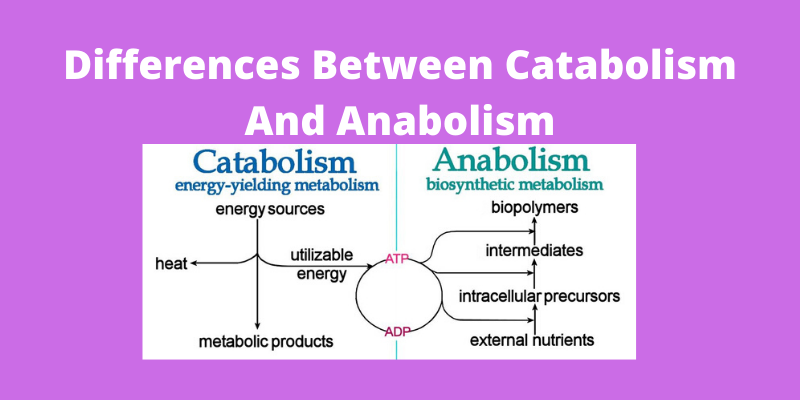Metabolism
Metabolism is a term used to describe chemical reactions or rates at which the body uses calories for the living state of the cells and the organism. To maintain a good metabolism rate nutrition is required. The metabolism has two subcategories; anabolism and catabolism. The main goal of nutrition is to keep anabolism always greater than catabolism. Anabolism means growth whereas, catabolism means breakdown. Learn the differences between catabolism and anabolism here.
Metabolism is the chemical process required for the functioning of organs inside a body such as breathing, digestion, repairing of cells, intense physical activities. During such activities the body uses calories and the body goes into a catabolic state whereas, nutrition intake after any intense activity helps the body to get into the anabolic state.
The key differences between anabolism and catabolism are as follows

Difference between Catabolism and Anabolism
| Characteristic | Catabolsim | Anabolism |
| Introduction | It is a metabolic chemical process used for breakdown of complex molecules to simple small molecules. | It is a metabolic chemical process used to build molecules required for the energy to do different activities by the body. |
| Energy | In this state body releases energy in different activities. | In this state body requires energy to keep body in anabolic state. Nutrition is the main source. |
| Energy Conversion | In catabolism state, energy is converted from potential energy to kinetic energy. | In anabolism state, energy is converted from kinetic energy to potential energy. Role |
| Effect on Human Body | Catabolism helps in burning fats and calories. | Anabolism helps in furnishing and preserving tissues and results in muscle growth. |
| Oxygen Usage | Catabolism uses oxygen. | Anabolism requires less oxygen compared to catabolism. |
| Functionality | Catabolism is in function during activities. | Anabolism is in function during rest or sleep. |
| Role | The main role is destruction in metabolism. | The main role is construction in metabolism. |
| Hormones | Hormones responsible in this state are Adrenaline, cytokines, cortisol, glucagon. | Hormones responsible in this state are Estrogen, testosterone, growth hormone, insulin. |
| Exercise | Catabolic exercise are usually aerobic exercises. In this the the body burns calories and fat. | Anabolic exercise are usually anaerobic exercises. In this the body generally builds muscle mass. |
| Example | In this chemical process; proteins become amino acids, glycogen becomes glucose, triglycerides becomes fatty acids. | In this chemical process; amino acids becoming proteins, glucose becoming glycogen, fatty acids becomes triglycerides. |
Catabolism
Catabolism is the subcategory of metabolism, which breakdowns large or complex molecules such as proteins, polysaccharides, and fats into small molecules like amino acids, monosaccharides, and fatty acids. It is a destructive state of metabolism. This process includes glycolysis and citric acid cycle.
The glycolysis is the metabolic process to convert glucose pyruvic acid and a hydrogen ion. It is a chain of ten enzyme-catalyzed reactions. The energy released in this process is used in the formation of NADH (nicotinamide adenine dinucleotide) and ATP (adenosine triphosphate).
The citric acid cycle is a sequence of chemical reactions used by aerobic organisms to stored energy derived from the oxidation of carbohydrates, fats, and proteins. Catabolism is a breakdown feature, whereas anabolism is a buildup feature of metabolism.
Catabolic Hormones
Adrenaline
Adrenaline is produced in the adrenal gland. It helps in acceleration of heart rate and acts as the main element of the “fight-or-flight” response. It is also known as epinephrine
Cortisol
Cortisol is also produced in the adrenal gland. This hormone is released during anxiety, nervousness, etc. It increases blood sugar levels, blood pressure. It is also known as the stress hormone.
Glucagon
Glucagon is produced in the pancreas. It helps in the breakdown of glycogen into glucose. It is stored in the liver and stimulates the liver to release glycogen when the body needs more energy for activities like fighting, exercise, high level of stress.
Cytokines
Cytokines are produced and broken down in the body when amino acids are reused for other functions in the body. It is a small protein that helps in the communications between cells.
Anabolism
Anabolism is another subcategory of metabolism, which helps in the construction of molecules from smaller units. It is the chemical process in which nutrients are used in the formation of comparatively complex molecules in the living cells with moderately simpler structures. This process includes making components of cells such as proteins, carbohydrates, lipids, which require energy in the form of ATP.
Anabolism is a buildup feature, whereas catabolism is a breakdown feature of metabolism. It is also known as biosynthesis. Anabolism helps in the building of macromolecules like proteins, nucleic acids, polysaccharides.
These macromolecules are produced from small molecules using enzymes and non-protein chemical compound that is required for an enzyme’s activities.
Anabolic Hormones
Testosterone
Testosterone is produced in the testes. It is present in males as well as females. Due to the regulation of testosterone some male sexual characteristics like facial hair, building muscle mass, voice, increase in bone strength takes place.
Estrogen
Estrogen is produced in the ovaries. It is present in females as well as males. Due to the regulation of estrogen some female sexual characteristics like breast enhancement, growth of hips, increase in bone strength, the menstrual cycle takes place.
Growth Hormones
Growth hormones are produced in pituitary glands. It regulates growth and stimulates during the early stage of life. In a mature human it helps in regulation of bone repair.
Insulin
Insulin is produced in the pancreas. it helps in the regulation of glucose and the blood level. When a body fails in the production of insulin, this leads to diabetes. If there is no insulin, the body cannot use glucose.
Reference
https://en.wikipedia.org/wiki/Metabolism






thanks for in lighting us
Thanks for lighting me more this aspect
Thanks for enlightening me more on this